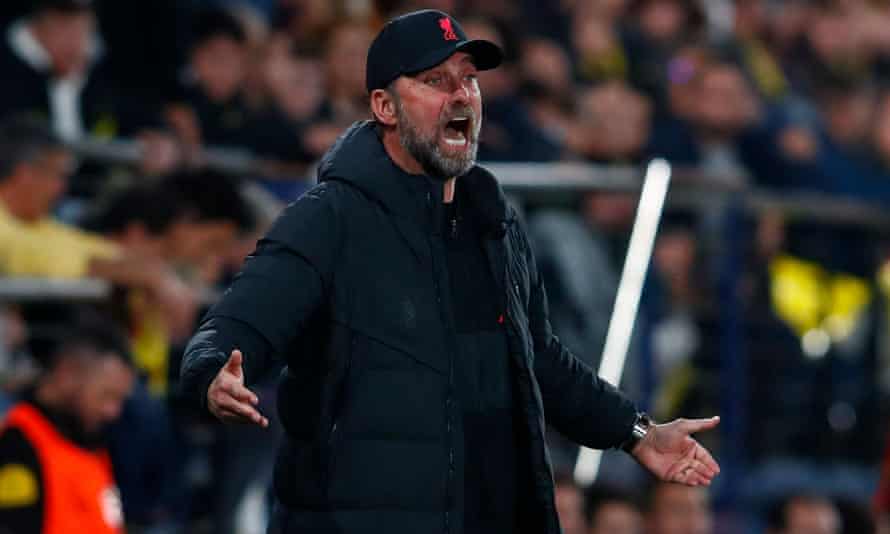Problem-solver Klopp presses reset to propel Liverpool into another final
Luis Díaz revved the engine, priming the afterburners. He blazed up the left, taking Juan Foyth, the Villarreal right-back, with him. He slowed and then he went again, purring away from him. The Liverpool winger had just entered as a half-time substitute in his team’s Champions League semi-final, second leg at the Estadio de la Cerámica and he was testing his marker, working out whether he had the beating of him. The answer was emphatic. He did.
Díaz knew it. So did everyone and, as Liverpool set about starting Tuesday night’s tie – albeit 45 minutes late – it felt as though something had been plugged in, the power returning.
For Jürgen Klopp, however, the catalyst lay elsewhere, in a detail closer to his heart, more fundamental. The Liverpool manager had watched everything go wrong in the first half, his team’s 2-0 first-leg lead wiped out – and it might have been worse.
Alisson had been fortunate not to concede a penalty just before Francis Coquelin scored Villarreal’s second goal and it was one of those challenges that, no matter how many times you watched the replay, it was difficult to tell what the goalkeeper had taken first – the ball or Giovani Lo Celso. It was messy, rather like Liverpool’s performance; framed by doubt, the benefit of which probably saved Alisson in the eyes of the VAR jury.
“The whole world thought the game was more 3-0 than 2-1,” Klopp said, going on to reveal that he wanted to show his players a clip at half-time of a positive moment to give them a lift. He would be told by his assistant Pete Krawietz that there was nothing available. There was no buildup play, no momentum, Liverpool scrambled by Villarreal’s fast start and Boulaye Dia’s third-minute opener. “We had 11 problems in the first half,” Klopp added, referring to each one of his players.
But Klopp felt the situation turn when Naby Keïta did likewise on to a pass into a seam of space. The midfielder had Sadio Mané in front of him, plus others, including Díaz and, at last, Liverpool were looking forward.
“We turned and we were running with four or five players towards their last line,” Klopp said. “Honestly, when I saw we could turn with the ball and for the first time pass through their line, I knew we had a good chance to turn it around.”
It felt like a relatively small moment – not as eye-catching, for example, as Díaz’s menace. But when a team have a style as well-grooved as that of Liverpool, a way which works, which they all know does work and will continue to work, it does not take much for the certainty to return.

It is what makes Liverpool such fearsome opponents. Even when they look down, there is always a way back and what was noticeable before they scored their three unanswered second-half goals to advance into the final in Paris on 28 May was the clarity of the thought processes, the calm after the first-half storm; the easy recalibration of the angles.
Klopp talked of facing a “football problem” at half-time, specifically the way that Villarreal had marked man-for-man and how his front three – Mané on the left, Mohamed Salah on the right, Diogo Jota up the middle – had been too static.
“You give the ball there [to the forwards] and Villarreal win the challenge,” Klopp said. “We couldn’t keep one ball in the front line in the first half because of the wrong movements.”
And nor could Liverpool build through the midfield for similar reasons. When Thiago Alcântara dropped deep, he came under huge pressure and could not see the options that he wanted.
“But if you press like Villarreal did, you open up other spaces,” Klopp said. “It wasn’t that Luis was the solution, it was that we moved more. The difference was what I was talking [to the players about] at half-time – that we started to do what we wanted to do in the first place.
“The first goal that we scored from Fabinho … it was a situation where he offered a run in an area where he never was before in the game. Just being in the half-space, offering that run in behind. We passed the ball through and he is a bit lucky with the finish [the shot going through the legs of the goalkeeper, Gerónimo Rulli] but we had to break their lines.”
It was not a classic Klopp comeback to rival those against Borussia Dortmund in 2016 and Barcelona three years later because Liverpool were not actually behind in the tie. This was what the players told themselves at the interval; it was 2-2, with the next goal standing to be crucial. And nor was it particularly wild – relying, say, on some moment of individual magic as certain clubs have done this season.
Liverpool simply reset mentally and trusted that the victory would be theirs when – and not if – they played as they wanted to play, moved as they wanted to move. “To be fair, it was calm,” Andy Robertson, the left-back, said of the dressing-room mood at half-time. The football solution was structured, cohesive. This is what champion self-assurance looks like.
Subscribe To Our Newsletter
-
How to get a free jersey
- How to get Pcs free jerseys Feedback Customer Reviews About Us Contact Us News FAQ
-
User Center
- Forget Password My Orders Tracking Order My Account Register
-
Payment & Shipping
- Customs & Taxes Locations We Ship To Shipping Methods Payment Methods
-
Company Policies
- Return Policy Privacy Policy Terms of Use Infringement Policy

